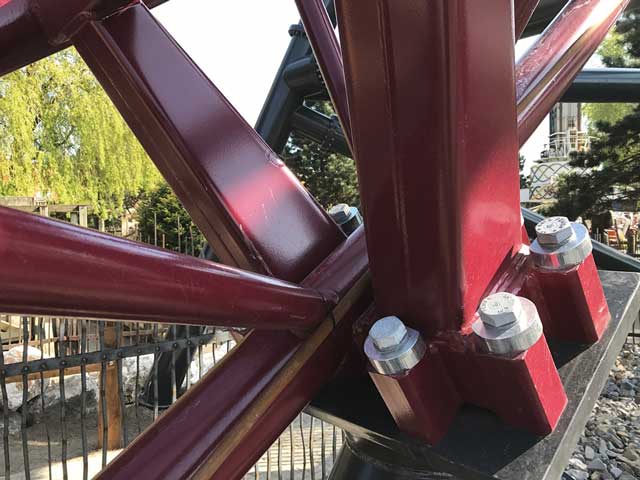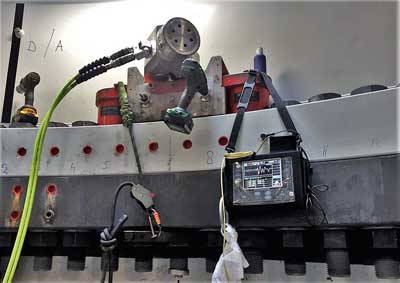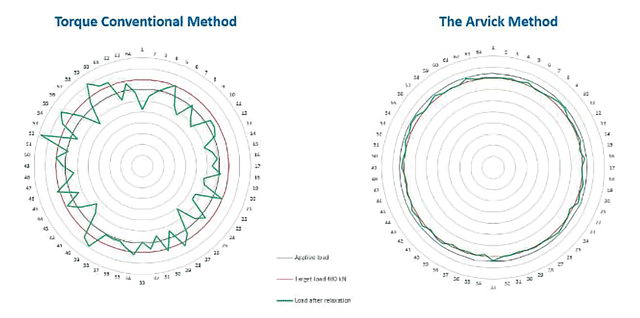
Ultrasonic testing can speed up the process of bolt tensioning in critical connections, while making sure specifications are met, says Gerrit Noltes of Arvick, on behalf of the British Institute of Non-Destructive Testing.
During the installation and maintenance of offshore wind farms, technical challenges regarding bolted flanged connections are often experienced. Such connections are found in critical locations such as the foundation connections and rotor blade connections, as well as in a range of other complex structures.
The cause of the challenges is often attributed to a dissatisfactory level of quality assurance in the manufacturing and installation of the flanges. A large amount of force is required to close the flange gaps and, in conjunction with an inefficient methodology, this creates possible integrity risks leading to early fatigue and failure of bolts under dynamic loads.
With high-value assets such as offshore wind turbines, it is in every stakeholder’s interest to maximise their lifetime. Therefore it is important that the structure’s flanges are secured in the best possible way.
Quality in flanged connections is measured by the accuracy of bolt load achieved after tightening and relaxation (a waiting time of 30 minutes is advised), compared with the target load of the bolt.
Traditionally, bolt load has been estimated using a direct correlation with the torqueing force. A more accurate method of determining bolt load in flanged connections can be achieved by measuring the change in the length of a bolt and converting this into load, using an ultrasonic bolt load measuring (USBM) device. Using the USBM device can reduce the safety factor necessary in the design of these connections, allowing for lighter connections and subsequently increased tower height.

However, even if the bolt load measurement is extremely accurate, but the flange tightening methodology is ineffective or inefficient, the quality of the spread in bolt loads around the whole flange will be unsatisfactory. An inefficient methodology requires additional tightening iterations around the whole flange, which increase the installation time.
Accurate and high-quality results can be achieved by setting up the USBM device, governed by strict procedures. The results are incorporated in the quality assurance documentation. It is crucial to have properly trained personnel in order to follow the procedures and successfully execute the scope of work.
Further, USBM assures the repeatability of bolt load measurements. This quality control system gives transparency in the results and the repeatability of the measurements allows for predictive maintenance.
Arvick, a bolting technology specialist based in the Netherlands, has developed its own methodology, known as the Arvick Method, which is a combination of torqueing and tensioning supported by the USBM. The Arvick Method requires only a single iteration of bolt tightening, making it a much faster process.

Using this method has advantages in QA, providing assurance that the bolt loads are up to the contract specifications for the engineering, procurement, construction and installation contractors, as well as providing data for the operation and maintenance body, which will allow Arvick to perform inspections and compare future data with the installation values.
To ensure the integrity of an applied methodology, Arvick is an experienced training provider of personnel for any project specific set-up. Safety, working in groups and equipment maintenance are important parts of the Arvick Academy.
Arvick aims to improve the offshore wind industry by bringing a higher quality bolted flange connection as a service, with transparency and repeatability. It provides a total solution, from smart design consultancy to effective and safe execution.
The British Institute of Non-Destructive Testing (BINDT) is seeking to work closely with Arvick for the purpose of developing personal certification for the ultrasonic technique used to measure applied bolt load: this will have a direct effect on operators’ competence and the quality of any final inspection provided.
For further information see the institute website at: www.bindt.org

